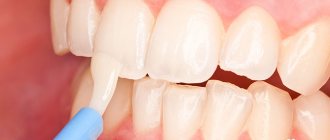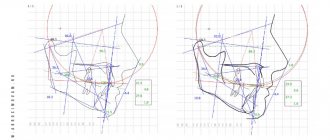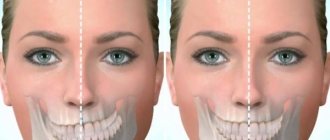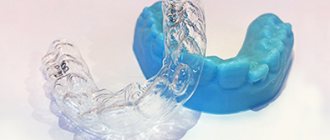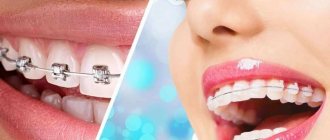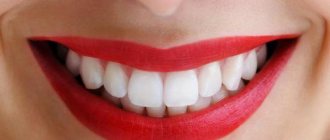Indications Contraindications How veneers are installed Pros and cons of veneering Veneers or braces Veneers or crowns
A beautiful, snow-white smile is one of the most common beauty standards. But perfectly straight teeth are quite rare. Some people have teeth that are too close to each other and crowd together, while others have teeth that are far apart, leaving gaps. Sometimes teeth are out of alignment or slightly tilted to the sides. Such defects are corrected by aesthetic dentistry. One of the common methods is veneering.
Veneers
– these are thin plates made of composite, ceramic or zirconium, which are used to correct a smile.
Place onlays on the front teeth, in the smile area. It is recommended to cover from 4 to 8 teeth
. The load on the lateral teeth is too strong for thin plates. It is better to put crowns on chewing teeth.
It is possible to install veneers on crooked teeth if certain conditions are met.
Indications for installation of veneers
- The presence of diastemas (gaps between the front teeth);
- chips, cracks, depressions, stains on the enamel;
- discoloration of teeth as a result of medical or dental treatment;
- single teeth protruding from a row;
- small, irregularly shaped teeth;
- slightly crooked teeth;
- gummy smile.
Veneers can correct the bite in the sense that in some cases, the onlays lift the bite, thus helping to bring back the “gone” lower jaw. This prevents problems with the temporomandibular joint and improves the quality of life.
To correct malocclusion, orthodontic treatment with braces or aligners (aligners) is necessary.
Why can’t you put veneers on an incorrect bite?
With malocclusion, the architecture of the dental system is changed. The load during chewing is carried out unevenly, which is why some teeth wear out faster than others.
It is pointless to install veneers on an incorrect bite, since they will quickly fail. They will crack and break, primarily due to uneven load. Therefore, if you have an abnormal bite, you must initially undergo orthodontic treatment (most often, braces). And after braces, you can consider the issue of restoration.
When is it better to refuse to correct your bite with veneers?
Like any intervention, veneering has limitations. The pads are not suitable for people suffering from bruxism. Grinding your teeth can ruin all your work. You should not install pads if you have the following pathologies in adults:
- periodontitis 3-4 degrees (teeth are very loose, gums are inflamed);
- thinning of enamel;
- significant damage to the crown (from 40%);
- lack of teeth in the area of prosthetics;
- severe curvature.
Sometimes it is possible to place veneers on crooked teeth after the condition improves or certain conditions are met. So, in case of infections, pregnancy, childhood, you just have to wait.
When are crowns used to straighten teeth?
If it is impossible to correct the crooked teeth with veneers, the doctor may offer the patient treatment using crowns. Like veneers, crowns can straighten one or more teeth.
They are usually installed on the front teeth. At the same time, dentures can restore teeth not only from an aesthetic point of view - with the help of crowns, functionality and anatomical shape are restored to damaged teeth.
It is important that the material for crowns is selected correctly - this will preserve the aesthetics of the teeth, and the installed structure will look natural, without causing discomfort to the patient. The best option is all-ceramic crowns. They best meet aesthetic requirements and, in terms of transparency and color, closely match natural teeth.
However, if you have a massive jaw, installing such crowns is not recommended. In this case, ceramic crowns, the frame of which is made of zirconium dioxide, are more suitable. If the smile area is subject to correction, then you should abandon metal-ceramic crowns, since they do not look entirely aesthetically pleasing.
How to install veneers
There are 2 ways to get a Hollywood smile:
- Install composite overlays directly in the doctor’s chair
- Make individual ceramic or zirconium plates based on an impression in the laboratory
The composite is inexpensive, installs quickly, and perfectly imitates enamel. Unfortunately, it is prone to shrinkage, absorbs pigments and wears out quickly.
Ceramic veneers are very durable, do not change color, and practically do not wear out. The main disadvantage is the cost.
The fact is that the process of making ceramic linings is expensive. It consists of several stages:
- Diagnosis and development of treatment plan
- Preparation: sanitation of the oral cavity, cleaning teeth from plaque
- Color selection
- Tooth preparation
- Taking impressions
- Record making
- Fitting
- Fixation
Consumables, the doctor's work, equipment, and the cost of the ceramics themselves make ceramic veneers more expensive than composite ones. But they do not need to be polished every 6 months and replaced every 3-5 years.
Possible problems
Complications when correcting a bite with veneers can arise for several reasons:
- Medical errors (ignoring indications, incorrectly chosen technique, violation of tissue preparation technology, etc.).
- Failure of the patient to comply with the doctor’s recommendations (eating too solid food, bad habits, passion for extreme sports).
- Poor oral hygiene.
Complications during the treatment process most often occur at the preparation stage. The most dangerous are burns from overheating and accidental opening of the pulp, ending in pulpitis.
To avoid this, the following rules must be followed:
- Grinding of the tooth is carried out intermittently, at the recommended speed of the bur, with the supply of coolant.
- Control the layer of material being removed.
- Take into account the anatomy of the teeth, the location of the pulp horn.
- Strictly comply with aseptic requirements.
Other complications include:
- Increased sensitivity of the restored tooth - a painful reaction to cold, hot, sour, sweet.
The syndrome occurs when too much tissue is removed during preparation or when the enamel is pathologically thin. To reduce sensitivity at the preparation stage, desensitizers are used - substances that seal the dental tubules. - Changing the color of products . Typically observed in composite structures due to ingestion of coloring foods. Smoking can also lead to darkening of the restoration.
- Chips and cracks of records .
They can occur both due to poor-quality material and due to violation of the rules for using veneers (too hard food, injuries). Composite structures can be restored in the patient's mouth. Ceramic ones cannot be repaired; if there is significant damage, they must be ground off and new ones installed.
Pros and cons of veneering
Dental overlays for correcting malocclusion not only make your smile attractive, they increase self-esteem and improve your psychological state.
Advantages of veneers:
- Short installation times
. Composite onlays require 1 appointment, and ceramic onlays require 2-3. - Exact imitation of enamel
. The ability to transmit light makes ceramics indistinguishable from natural teeth - Biological inertia
. Allergy is not a contraindication. - Resistant to pigments and dyes
. Unlike natural teeth, ceramics do not change color over time. - Durability
. Ceramic compounds are several times stronger than composite ones. - Wear resistance
. If the recommendations are followed, ceramic linings last up to 20-25 years. Plates are replaced more often because the cement (adhesive) that attaches them to the teeth wears out.
97%
[1] Veneers are functioning perfectly 7 years after installation.
83%
[2] – after 20 years.
Several factors influence the lifespan of veneers:
- doctor's qualifications;
- mastery of technique;
- compliance with manufacturing and fixation technology;
- quality of materials;
- patient compliance with recommendations.
Therefore, it is recommended to choose large clinics with their own dental laboratories. The dentist and technician work together in such centers, discuss problems and find the best ways to solve them. The third member of the team is the patient.
It must be remembered that no veneer, even the most durable, can resist cracking nuts or biting wire. But curvature can be corrected with plates in a high-quality and long-term manner only if the recommendations are followed.
Disadvantages of veneers:
- The need for tooth preparation. Once you install veneers, you won’t be able to refuse them.
- High price. However, in the long term, ceramic veneers pay off. They do not need to be regularly polished and replaced with new ones.
Who are veneers contraindicated for?
As already mentioned, veneers do not correct the bite, but only mask it. Moreover, improper closing of the jaws is one of the serious contraindications to the installation of veneers. Occlusal anomaly - a violation of the interaction of the upper and lower dentition - this pathology constantly has a destructive effect on the teeth, including the aesthetic restoration linings installed on them. Veneers will simply fall off, even ceramic ones, not to mention composite ones.
Occlusal anomaly
In addition, there are a number of other contraindications.
- Composite veneers: what they are, how they are installed on teeth
- Veneers are not placed if there are no chewing teeth.
- This alignment method is not suitable for patients diagnosed with bruxism (involuntary periodic clenching of the jaws or “teeth grinding”).
Bruxism
- You should not resort to cosmetic restorations if you have damaged your teeth with bad habits, such as cracking nuts or opening bottle caps, and intend to continue doing so.
- Venirization is contraindicated in cases of severe malocclusion.
- Overlays are not used if you are an athlete and your sport involves possible jaw deformation (boxing).
People who engage in traumatic sports do not get veneers
- If, in addition to curvature, a large percentage of teeth are significantly damaged, or there are fillings on the teeth that cover more than ½ of their area.
What is better – correcting crooked teeth with veneers or braces?
Comparing these treatment approaches is difficult. Braces correct malocclusions, and veneers mask defects.
| Veneers | Braces | Aligners (aligners) | |
| Tooth preparation | The enamel is removed to a depth of 0.2-0.7 mm | Not carried out | Not carried out |
| Duration of treatment | Up to 2 weeks | Up to 2 years | Up to 3 years |
| Severity of defect | Lightweight | Deep | Deep |
| Diet changes | For 2-3 days | Yes, all the time of treatment | No |
| Care | No special care required, just be careful when using it | Careful hygiene required | Careful hygiene required |
When they say that veneers correct the bite, they mean the aesthetic aspect. Braces and aligners eliminate deep violations.
Bite disorders and their features
To understand whether veneers will correct your bite, you first need to understand the types of abnormal occlusion. The canines and incisors have sharp edges, and the chewing teeth have ridges. With an anatomically correct bite, the cutting and chewing parts correspond to each other and close tightly. If this relationship is violated, doctors talk about the presence of defects. In dental practice, the following types of abnormal bite
:
- Open bite
. Appears in the presence of a hereditary predisposition, as well as congenital anomalies of the facial bones. With such a defect in the frontal zone, there is completely no contact between the jaws. - Distal bite
. A characteristic feature of the anomaly is protrusion of the upper jaw with partial or complete absence of contact between the incisors. There may or may not be contact between the molars. - Crossbite
. It is formed in the presence of developmental anomalies of both jaws. With this deviation, the lower jaw is shifted to the side, and the upper jaw is greatly narrowed. Therefore, the relationship between the rows is disrupted in both planes. - Mesial bite
. It is characterized by a complete lack of contact between the incisors and protrusion of the lower jaw. In mesial occlusion, contact between molars may be maintained. - Deep bite
. A characteristic sign of such an anomaly is a significant overlap of the lower incisors with the upper ones. This violation leads to rapid wear of the enamel, resulting in a risk of tooth decay.
In the formation of an abnormal bite, not only the teeth, but also the bones of the jaw and skull most often take part. This is why changing the bite with veneers is often not possible.
Cost of treatment
The cost of treatment is individual in each specific case, since all patients have different combinations of problems, and different solutions can be chosen. After diagnosis and discussion of treatment options, the Family Dental Clinic prepares an estimate for treatment, which indicates the cost of the upcoming treatment, payment stages and deadlines. In the clinic’s price list you can find out the cost of veneers, crowns, and other individual services, but to determine the cost of your particular treatment, you need an in-person consultation and additional diagnostics.
Price question: how much does it cost to install veneers?
As we already said, dental veneers are not cheap, but they are worth it!
Approximate cost of microprostheses:
- Composite ones are the most budget-friendly. The cost of one unit is approximately 7 thousand rubles;
- Ceramic microprostheses, which are manufactured in a dental laboratory, cost approximately 20 thousand rubles per unit;
- Ceramic dental veneers made at the 32 Dent clinic will cost the patient about 15 thousand rubles per unit;
- Lumineers are the most expensive - from 50 thousand rubles per unit.
